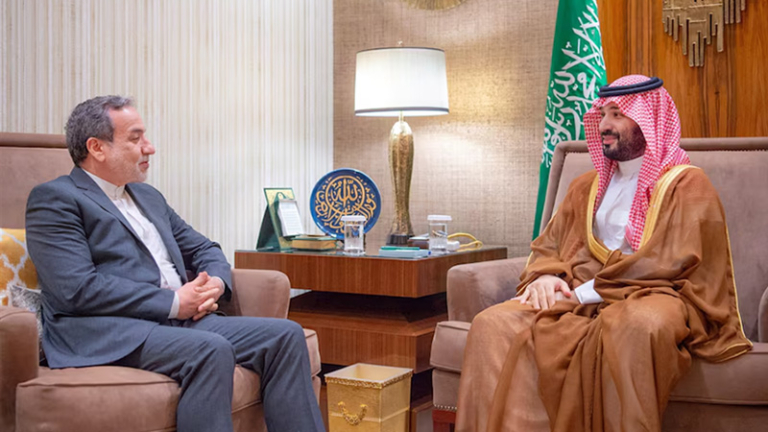
As regional leaders gear up for President Donald Trump’s first politically substantive overseas visit in his second term in office—to Saudi Arabia, Qatar, and the United Arab Emirates (UAE)—the issue of Iran looms large, just as it did when he made Saudi Arabia the destination of his first foreign visit in his first term in May 2017. In his remarks in Riyadh eight years ago, Trump focused on the twin threats of Iran and regional extremism to stability and security, but within weeks of his visit any notion of a common front among America’s Gulf partners dissolved, as Saudi Arabia, Bahrain, and the UAE launched their blockade of neighboring Qatar. The resulting standoff was the longest and deepest rift in the history of the Gulf Cooperation Council (GCC), and was only resolved in January 2021—the day before Trump supporters’ January 6 storming of the US Capitol in Washington—during the political transition from the Trump presidency to the incoming Joe Biden administration.
This time around, there are strong and striking differences in the regional mood that will greet the presidential delegation when it arrives in Saudi Arabia on May 13 to attend a planned summit of GCC leaders the following day, before continuing on to Doha and Abu Dhabi. After a tumultuous 100 days in office, with mounting legal challenges to, and growing public disapproval of aspects of US policy, the White House will want Trump’s first major foreign trip—other than that to the Vatican for Pope Francis’s funeral—to go well. This is especially the case as other key elements of the administration’s seemingly haphazard approach to foreign affairs have only produced very limited—and diminishing—returns, as Trump has failed to end the Ukraine war, the fragile ceasefire in Gaza has collapsed, and the indirect US-Iran nuclear dialogue hangs in the balance.
GCC Enabling Roles
It is little surprise that the Gulf states have played enabling roles in facilitating the talks involving American and Iranian officials, which began on April 12 and continued with further meetings on April 19 and April 26. A letter from Trump to Iran’s Supreme Leader Ayatollah Ali Khamenei was initially sent in March through an Emirati intermediary, and the Iranian response was sent via Oman, befitting the Sultanate’s trusted status among all parties. In addition, a visit to Muscat by Iran’s Foreign Minister Abbas Araghchi on March 16 moved the process forward. In 2013, when Oman facilitated months of back channel dialogue between US and Iranian officials during the Obama presidency, Araghchi had headed the Iranian delegation and was able to find sufficient common ground with Deputy Secretary of State William Burns, his American counterpart, to progress to open negotiations that involved the five permanent members of the United Nations Security Council, Germany, and the European Union.
It is little surprise that the Gulf states have played enabling roles in facilitating the talks involving American and Iranian officials.
While the fourth round of Trump administration-Iran talks scheduled for early May 2025 was postponed, the GCC states appear to remain supportive of the process of engagement between Iran and the United States and the choice of Oman as facilitator. Omani officials retain the trust of their counterparts in Tehran and Washington, and a desire for diplomacy is consistent with the direction of travel in the Gulf over the past five years. Indeed, it is the shift away from the geopolitical confrontations of the previous decade and toward diplomacy, that is the single biggest difference in the regional landscape that will greet the US delegation when they arrive in the Gulf.
Leaders of the six GCC states have worked assiduously since 2021, if at somewhat different paces, to repair and rebuild ties with Iran, as part of a ‘de-risking’ strategy designed to take the sting out of regional instability as rulers redoubled focus on post-pandemic economic and infrastructure investment. The best known of these initiatives, Saudi Arabia’s Vision 2030, is approaching its year of reckoning, with a series of ‘giga-projects,’ many along the kingdom’s Red Sea coastline, seemingly struggling to make progress. Elsewhere, Qatar is nearing completion of the first phase in a three-stage process that will nearly double its production capacity of Liquefied Natural Gas by 2030, and the UAE is investing heavily in artificial intelligence and other future-proofing technologies, while Oman is rapidly developing its hydrogen sector.
The Trust Factor
The single biggest factor in the Gulf that changed regional calculations vis-à-vis the United States and Iran was the September 2019 missile-and-drone attack on Saudi oil infrastructure that temporarily knocked out half the kingdom’s production. Part of a series of attacks on energy and maritime targets in Saudi Arabia and the UAE between May and September, the pinpoint strikes on the Abqaiq oil processing facility and the Khurais oilfield were linked to, but never formally attributed to, Iran. However, what caused shockwaves in Riyadh and other Gulf capitals such as Abu Dhabi was the reaction of the first Trump administration, when President Trump drew a distinction between US interests and theirs, and declined to take any overt action to respond to the attacks. Trump’s inaction led Saudi and Emirati leaders to question US credibility as a security partner and provider of deterrence against regional threats.
Trump’s inaction led Saudi and Emirati leaders to question US credibility as a security partner and provider of deterrence against regional threats.
Almost immediately after the 2019 attacks, senior officials in Riyadh and Abu Dhabi reached out (separately) to Iranian counterparts to try and de-escalate tensions in the Gulf, through direct engagement in the Emirati case and indirectly using Iraq and Pakistan as intermediaries for the Saudis. The shift in approach from bellicose rhetoric to pragmatic coexistence became evident as early as January 2020 when Saudi and Emirati officials called for restraint after US-Iran tensions soared in the aftermath of the US killing of Qassem Soleimani, the commander of Iran’s Quds Force, in a drone strike in Baghdad. Beginning in April 2021 and continuing through 2022, Saudi and Iranian officials held multiple rounds of talks in Iraq and Oman in a process that culminated in the March 2023 agreement in China to restore diplomatic ties that had been cut in 2016.
The decision to involve China as broker and effective underwriter of a deal that the United States could arguably never have struck, given Washington’s lack of diplomatic ties with Iran, spoke volumes, as did the fact that Saudi normalization took place with the Islamic Republic, rather than with Israel, which had been the focus of so much Washington speculation. At a time when the Biden administration had abandoned efforts to re-enter the Iran nuclear deal and as the shadow war between Iran and Israel became more openly combative, Saudi Arabia and Iran, as well as their Chinese hosts, sent a message to the United States that cooperation was preferable to confrontation. Moreover, the deal reached in Beijing in 2023 has proved durable. Among other challenges, it has survived a major stress test in the form of Israel’s war on Gaza and the extension of the fighting to Lebanon, as meetings between Iranian and Saudi leaders became more frequent and took place at ever-more senior levels.
Positive Responses All Around
Against this backdrop, officials in the Gulf states have responded to the flurry of indirect talks between Iranian and US negotiators with cautious optimism, with the Saudi foreign ministry expressing hope that the talks would enhance ‘peace in the region and the world.’ The mood music in Gulf capitals is very different from the previous era of negotiations in 2013 and 2014 that culminated in the signing of the Joint Comprehensive Plan of Action between Iran and the P5+1 and the European Union in July 2015. A decade ago, there was anger and recrimination toward the United States, especially in Saudi Arabia and the UAE but also in Israel, at their exclusion from the negotiating process for a deal that seemed to them to focus too narrowly on the single issue of the nuclear file at the expense of broader concerns about Iran’s regional activities. The 2015 agreement also came in the middle of a decade of geopolitical confrontation as regional states jockeyed for position in the aftermath of the 2011 Arab uprisings and the conflict and instability that followed.
Gulf states are far more aligned in support of diplomacy with Iran than they were in the mid-2010s.
Two issues in particular are noticeably different in 2025. The first is that while the JCPOA negotiations in 2013-14 were preceded by a secret backchannel between American and Iranian officials (facilitated by Oman), the current dialogue has been publicized, and Iranian officials have kept their GCC counterparts informed of progress. This reduces the possibility of misunderstanding if or when the talks continue, and securing the buy-in of the Gulf states will be critical to ensuring the success of any expanded dialogue or agreement. The second difference is that the Gulf states themselves are far more aligned in support of diplomacy with Iran than they were in the mid-2010s, when deep fractures prevented the articulation of a common position on regional affairs. When the then-ruler of Kuwait Sabah al-Ahmad al-Jaber Al Sabah attempted to reach out to the Iranian leadership in January 2017, as the first Trump administration entered the White House, his initiative gained little traction other than from Sultan Qaboos of Oman, and was overtaken four months later by the Saudi-Emirati-Bahraini decision to move against Qatar and issue a list of demands to Doha that included cutting diplomatic ties with Iran.
In addition to hosting and facilitating the initial three indirect meetings of US and Iranian officials so far in Muscat as well as at the Omani Embassy in Rome, the Omani leadership has been actively engaged on the international stage, likely to build consensus for the talks. Sultan Haitham bin Tariq Al Said traveled to the Kremlin on April 22, 2025 to meet with Russian President Vladimir Putin and received British Foreign Secretary David Lammy in Muscat five days later; the Iran talks were on the agenda in both meetings. On April 17, Putin hosted Iranian Foreign Minister Araghchi (and met separately with Emir Tamim bin Hamad Al Thani of Qatar for talks that focused more on Syria), and on the same day, Saudi Arabia’s Defense Minister Prince Khalid bin Salman, the younger brother of Crown Prince and Prime Minister Mohammed bin Salman, made the highest-ranking Saudi visit to Iran in nearly 30 years to meet with senior Iranian defense officials.
With this plethora of visits in mind, the outlook for regional diplomacy is more robust in 2025 than it has been in a long time, perhaps as far back as the turn of the 21st century and the shocks of 9/11, the US invasions of Afghanistan and Iraq, and the sharpening of sectarian tensions after the US occupation of Iraq in 2003. This is not to ignore or to downplay the ongoing risks of escalation from Israel’s renewed and expanded offensive in Gaza or from the cycle of violence involving American, British, and Israeli airstrikes on Houthi targets in Yemen and their response. And yet, the economic dividends and investment opportunities that the Trump administration will seek from the president’s upcoming Gulf trip would be threatened by a regionwide conflict, especially one involving Iran; this is an issue that GCC policymakers may well emphasize in bilateral and regional meetings as they go forward.
The views expressed in this publication are the author’s own and do not necessarily reflect the position of Arab Center Washington DC, its staff, or its Board of Directors.
Featured image credit: SPA

